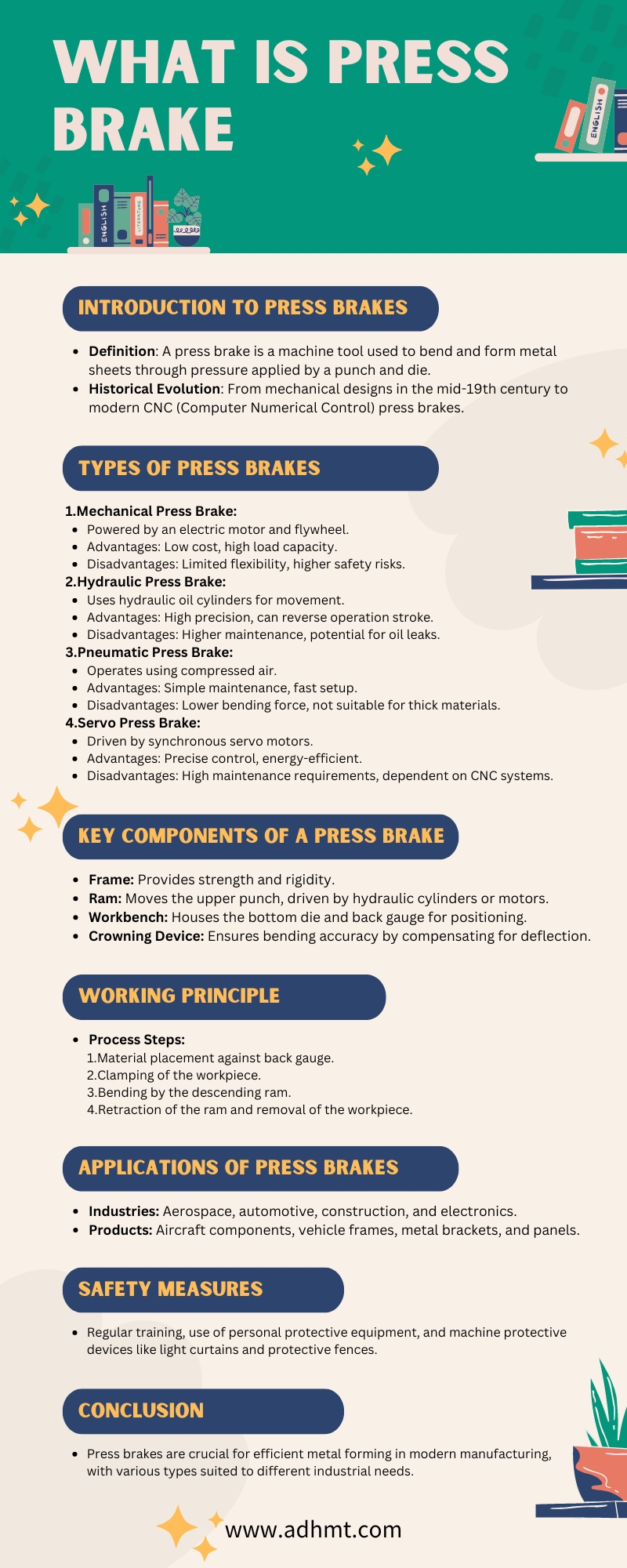A press brake is an indispensable piece of equipment in the metal fabrication industry. It is mainly designed for the precise bending and forming of thin plate sheets. A press brake is a machine tool used for metal sheet processing. It exerts pressure on the metal sheet via the upper and bottom tools, causing plastic deformation and bending. The upper tool is usually named the punch, and the lower tool is called the die. It is widely used in various industries, such as automobiles, aviation, electronics, and construction, which play a vital role in metal processing. The basic working principle of the press brake is to utilize the upper punch and bottom dies to exert pressure on metal sheets. The metal sheet is placed in the V-shaped notch of the bottom die, and then the top punch descends, causing plastic deformation and forming along the V-shaped notch bending, thus acquiring the bending angle. By changing the different shapes and sizes of tools, the press brake can process the workpiece with a variety of geometric shapes and angles. The press brake is mainly composed of a frame, ram, workbench, hydraulic system, etc. The frame supports the whole equipment and is made of a steel welded structure to ensure enough strength and rigidity. The ram is installed with an upper punch and moved by hydraulic cylinders. The workbench is equipped with a bottom die and a back gauge device for positioning sheet metal. Moreover, the press brake is equipped with a crowning device, synchronization device, etc., to improve the bending accuracy. The press brake produces precise bending in the workpiece through force, dies, and specialized tools. Factors such as toolings, material characteristics, bending radius, and bending methods can all affect bending accuracy. According to machine design and specific application requirements, bending can be carried out through various driving forces, such as mechanical, pneumatic, hydraulic, or servo-electric. However, the main sources of bending power currently used are hydraulic, servo, and electric. NC press brake machines are early conventional bending machines. NC press brakes use the torsion bar to connect the Y-axis on both sides of the ram (left Y1 and right Y2) and to drive hydraulic cylinders on the uprights. Then, the ram can move up and down synchronously to bend metal sheets. NC press brakes are very suitable for low-cost, easy-to-operate workpiece bending but not high-precision and high-volume production. Since the NC press brake is mechanically synchronized, it cannot provide real-time feedback on the bending error and automatically adjust the error. This can lead to poor bending accuracy. In addition, the NC press brake drives cylinders up and down through the torsion shaft, and the long-term load can lead to the deformation of the torsion shaft. CNC is the abbreviation for Computer Numerical Control. CNC press brakes are essentially mechanical tools that integrate a computer numerical control system with hydraulic press brakes. Generally speaking, CNC press brakes are driven by a hydraulic or electrical system. After being equipped with the computer numerical control system, the press brake is able to effectively and precisely bend metal materials into various desired profiles. Hydraulic press brakes occupy the vast majority of bending equipment use share. They are the most widely used bending equipment in the bending industry. The hydraulic press brake is powered by the hydraulic system. Y1 and Y2 axis control oil cylinders directly drive the ram to do the synchronous movement. Hydraulic press brakes have a long history of utilization and mature technology development. During the bending operation, hydraulic press brakes are stable and reliable and are very suitable for large-volume, heavy-tonnage workpiece processing. The purely electric CNC press brake is driven by an electric motor and does not use hydraulic devices or oil cylinders, so there is no problem with oil leakage. Also, the motor only starts when bending is required and automatically shuts off when not in use. This reduces energy consumption and bending costs. Electric press brakes can provide accurate and fast bending operations. However, an electric press brake is more suitable for dealing with smaller tonnages. CNC press brake can be divided into two types according to the movement of the upper tools (punch) and lower tools (die). Down moving: It includes a fixed worktable (bottom), which fixes the lower tools (dies) on the table. The upper tools (punch) are subjected to a downward force, and the upper and lower dies act together on the sheet metal to complete the bending process. Up moving: This type of press brake has the same parts as the first type of bending machine. However, in this type, the upper part is fixed and the bottom part is the moving counterpart. The bending preparation time of the CNC press brake is very fast because there is a CNC system that accurately calculates the position of the ram and back gauge. The CNC press brake can also check for errors during the bending process, switch between different bending modes, and position desired to bend angles and lengths. Additionally, the CNC system is able to calculate the correct bending sequence, repeating the bending action several times until the sheet metal is produced into profiles. Overall, the CNC press brake is programmable for the entire bending process and is able to provide high-precision, customized bending. According to the different force application methods, press brakes can be primarily divided into mechanical press drive, hydraulic press drive, and pneumatic and servo press drive. Although different types of press brake vary in characteristics, the main difference consists in the power running the machine. The main parts of mechanical press brakes include a workbench, ram, electric motor, flywheel, clutch, and brakes. The flywheel is driven by an electric motor. Through the clutch, it is connected to the gear shaft to maintain the ram's motion. The brakes stop the movement of the gear shaft as soon as the drive shaft is disconnected from the flywheel. It is low-cost in the early stage owing to relatively simple and outdated technology. It has a small wear cost and low maintenance cost. It has high bending and load-bearing capacity, which can exceed the rated tonnage 2-3 times. It is also friendly for beginners because it is easy to operate and has an intuitive control system. It can neither adjust the stroke during bending nor reverse it at any time, which is poor flexibility. It can not perform more intricate bending work, and its functions are limited. Also, it has higher safety risks and is not as fast as a hydraulic press brake when changing tools and adjusting. The hydraulic press brake drives the ram movement with two synchronized hydraulic oil cylinders. The light curtain safety device of the hydraulic press brake allows the ram to be stopped at any time, reverse the operation stroke, and control the speed. Hydraulic press brakes with a CNC system can intelligently handle the bending of different materials, including thickness, length, tonnage, angle, etc. It has high intensity and nice rigidity, smooth and reliable operation, high precision, and versatility. It can handle a variety of materials, including metal sheets. It has overloading protection to avoid damaging the die and machines. Hydraulic press brakes are divided into torsion shaft press brakes, mechanical hydraulic press brakes, and electro-hydraulic press brakes. Complexity and maintenance, noise pollution, potential for oil leaks and spills, slower approach and return speeds compared to electric press brakes, high initial cost, and significant floor space requirements, especially for larger models. The power source of the pneumatic press brake is mainly compressed air or gas. The air pressure generated by the gas is used to apply tonnage to the ram for bending. The machine delivers compressed air to the cylinder or pipe connected to the pressure mechanism. When filled with gas, the pressure drives the tooling downward. After the movement is complete, the gas is discharged through the exhaust valve, and the brakes return to their initial position. It has low requirements for operation and training. It is fast to set and adjust the time, simple to maintain, and has fewer pneumatic components, which can save maintenance costs. Due to low pressure, it is hard to bend thick materials. Compared to hydraulic press brakes, it makes more noise. Its bending ability and bending force are lower than those of hydraulic press brakes. The power of the servo press brake mainly comes from two synchronous servo motors, which provide energy through belts and pulleys. The servo press brake is usually suitable for bending a small number of customized workpieces. The servo press brake is very flexible. The servo motors accurately control the stroke and speed of the ram. The operating sound of the servo press brake is very low, and it will not produce noise during operation. When the bending starts, the servo motors start running; when it stops, the servo motors will also stop. This may save power and reduce production costs. Moreover, the servo press brake is not equipped with oil cylinders, so the problems of oil leakage and cleaning do not need to be considered. It has high requirements for the operating environment. Highly dependent on the stability and operability of CNC systems. It is hard to maintain and repair the servo press brake. Once trouble occurs, it requires high techniques and a long time. Material placement: place the metal sheet on the press brake bed against the back gauge fingers for proper alignment. Note: Press brake dies are crucial for bending sheet metal. They consist of the upper die (punch) and the bottom die (die). Only matched punches and dies working together on the metal plate can produce the final profile. During bending, extrusion and friction occur between the dies and the sheet metal, leading to die wear over time. The huge pressure generated when the dies bend the metal plate can cause the temperature of the contact surface to rise, damaging the dies. Press brake tooling is not suitable for dealing with metal plates with high hardness and thickness, especially cylindrical workpieces. The press brake's back gauge is located behind the machine and is used to position the workpiece. The more shafts there are for the back gauge, the higher the workpiece's bending accuracy. The press brake controller can control the movement of multiple components, including toolings, back gauges, etc. The light curtain system of the press brake can protect the operator from being injured by the machine. When selecting press brake dies, the die material's hardness, heat resistance, and wear resistance must be considered. The hardness, thickness, length, and ductility of metal plates should also be considered. Appropriate materials for the plate being bent should be selected for the dies. Generally, the bottom die is used according to the standard of 5 ~ 6T, and the length is longer than the metal plate. When the material is harder, and the thickness is larger, the dies with wider grooves shall be used. When selecting the punches, the angle of the workpiece should be determined according to the shape of the product so as to select the appropriate punches. There are many kinds of materials for press brake punches and dies. Steel is currently the preferred material for making press brake dies. For example, carbon tool steel, low alloy tool steel, high carbon high chromium or medium chromium tool steel, medium carbon alloy steel, high-speed steel, matrix steel, cemented carbide, steel bonded cemented carbide, etc. These high-quality steels are made by special heat treatment. They are highly hard, not easy to wear, and have a strong load capacity. However, they must not exceed the limited pressure that the dies can bear during bending. 90-degree dies, acute angle dies, beading dies, box-forming dies, channel-forming dies, corrugating dies, curling dies, four-way die blocks, gooseneck dies, hemming dies, multiple-bend dies, radius dies, rocker-type dies, rotary bending dies, seaming dies, tube, and pipe forming dies, u-bend dies, and V-dies. A press brake is mainly used for bending and forming metal plates. In the past, workers could only bend metal plates by pounding them manually. With the continuous development of science and technology, mechanical press brakes, hydraulic press brakes, and electric press brakes have entered the market one after another. Currently, press brakes are widely used in various fields of processing and production to improve production efficiency. Press brakes are mainly used for metal processing and manufacturing in the aerospace, automobile, marine industry, agriculture, energy, military, transportation, and other fields. In the automotive industry, press brakes can produce body panels, frames, and brackets. In the aerospace field, press brakes can produce aircraft components and fuselage structures. It can also produce moulded metal shells and covers for electronic equipment. The press brake operator should follow the following safety measures and practices to avoid potential hazards: In Old English, "brecan," "break," "brake," and "breach" are cognate words. "Break is "breken" in Middle English, which means "destroy, break, fragment, and bend." While "brake" develops from "breken" and "break". Therefore, their meaning is also very similar. In the middle ages, people used "brake" to represent a tool used to pound and crush grain. Later, "brake" gradually became synonymous with “machineâ€. Therefore, people called the machine used for pressing as "press brake". "Press" in Medieval English means "press, strike, hit, pound". Later, people used "press" to represent a machine used to squeeze clothes or juice. Therefore, "press" means a tool that can apply force to an object. "Press brake" in modern machines means a machine that applies force to bend metal plates. This passage discusses the press brake's concept, working principle, and importance. I hope you can have a more comprehensive understanding of the press brake and recognize its vital role in modern industrial manufacturing. When exploring the press brake world, it is pivotal for you to choose a mature and advanced supplier. My company, ADH Machine Tool, is such a reliable partner. We specialize in offering high-quality press brakes, shearing machines, and laser-cutting machines. Our products are well-designed and perform well to meet your various sheet metal processing needs. I cordially invite you to visit my company's product page to learn more about our product press brake range and technical advantages. Whether for effective solutions for improving production efficiency or improving product quality via advanced technology, we all offer you professional support. Download the Infographic With High Resolution Titanium Cookware,Titanium Spatulas,Titanium Fry Pan,Titanium Pot Bao Ji Titour Technology Co.,Ltd , https://www.cntitour.comI. Introduction
With the development of technology, from the mechanical press brake in the mid-19th century to the emergence of the electric press brake in the early 20th century and then to the introduction of computer numerical control technology, the function and efficiency of the press brake have significantly improved.
It can bend the sheet into various angles and improve processing accuracy and production efficiency via CNC functions.
Our passage will deepen into the types, basic structures, working principles, usages, etc., to help you understand this machine more comprehensively.II. What Is Press Brake?
Definition
Working principle
Main structures
Factors affecting bending accuracy
What Is NC Press Brake
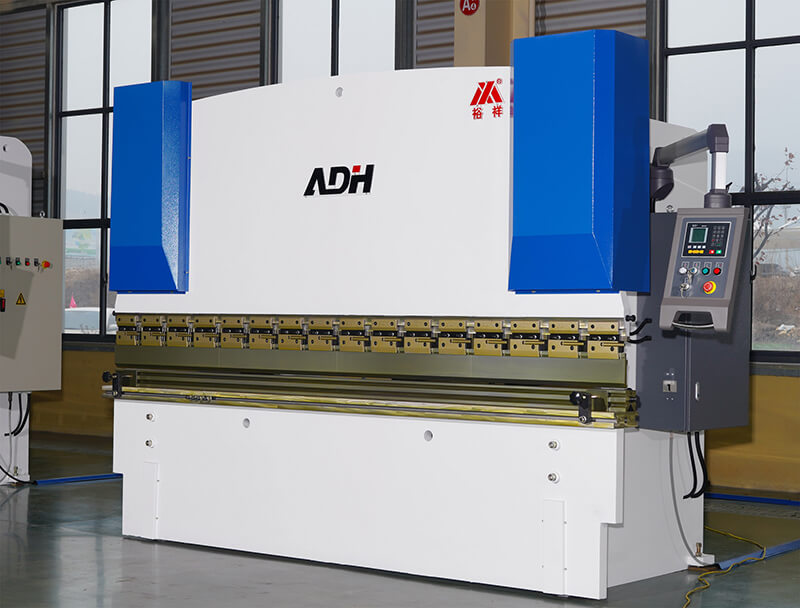
What Is CNC Press Brake
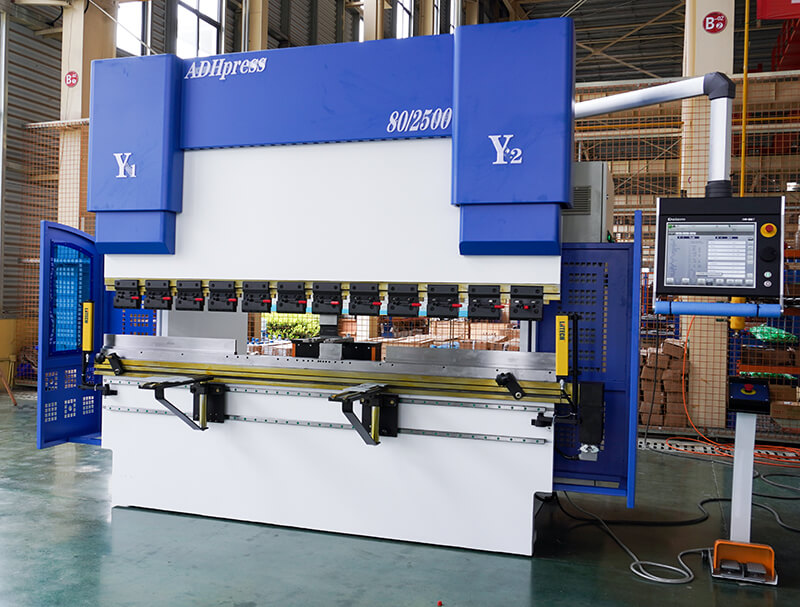
III. What Are the Types of Press Brakes?
Mechanical press brake
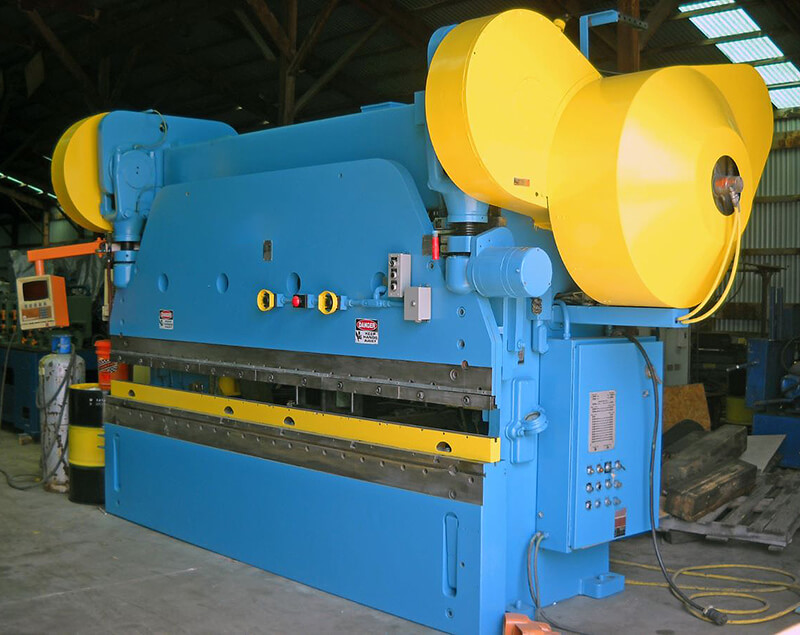
Advantages
Disadvantages
Hydraulic press brake
Advantages
Disadvantages
Pneumatic press brake
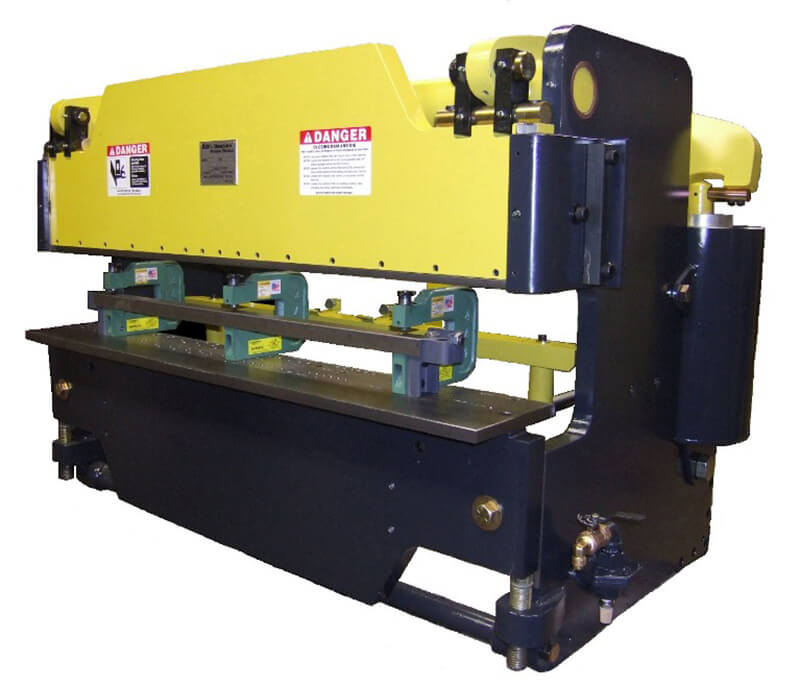
Advantages
Disadvantages
Servo press brake
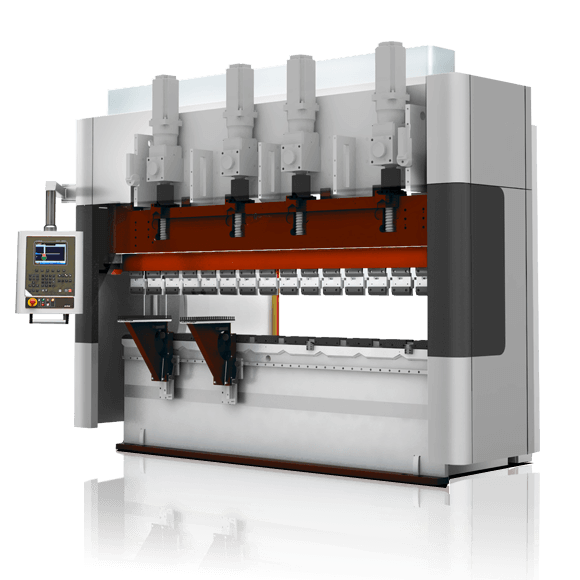
Advantages
Disadvantages
IV. How Does a Press Brake Work?
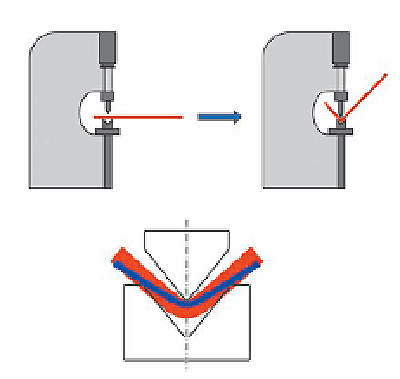
How a Press Brake Works: Step-by-Step
Clamping: the workpiece is fixed firmly between the upper punch and bottom die. Proper clamping force is vital for avoiding slipping during bending.
Bending: the ram (bearing the upper punch)descends and exerts pressure on the workpiece, pressing it into the V-shaped holes of the bottom die. This deforms the metal into the required bending angle.
Retract: after achieving the programmable bending angle, the ram retracts and releases the workpiece pressure.
Release and remove: release the clamping device, and the operator will move the workpiece from the press brake bed.Comparison
Power source Describe Mechanical By synchronously driving the slider movement through the oil cylinders on the two side pillars, the stroke and tonnage can be stopped and adjusted during the bending process. Hydraulic type By synchronously driving the slider movement through the oil cylinders on the two side pillars, the stroke and tonnage can be stopped and adjusted during the bending process Pneumatic Using compressed air to drive slider movement Servo motor type Precise control of slider movement using servo motors
V. What Is Press Brake Punch and Die?
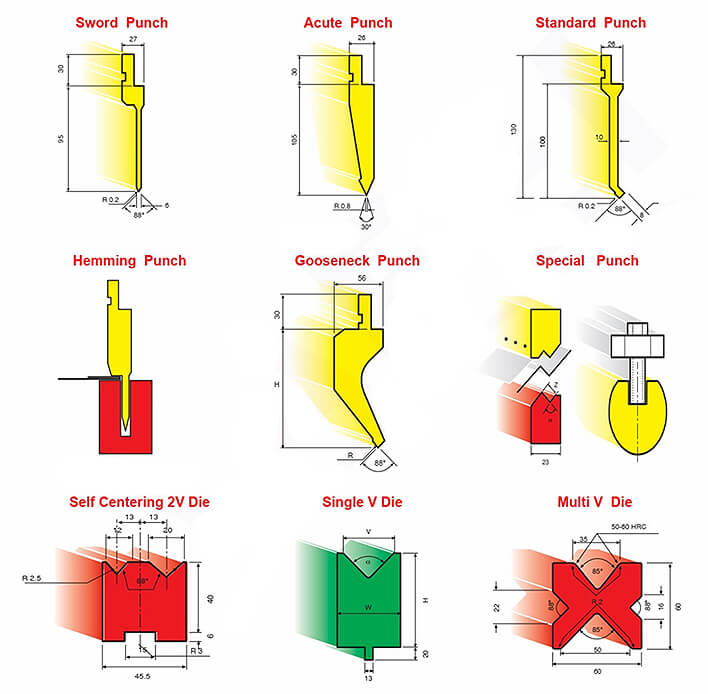
How to Select Press Brake Punches and Dies
Types of Press Brake Punches and Dies
VI. What Are Press Brakes Used for?
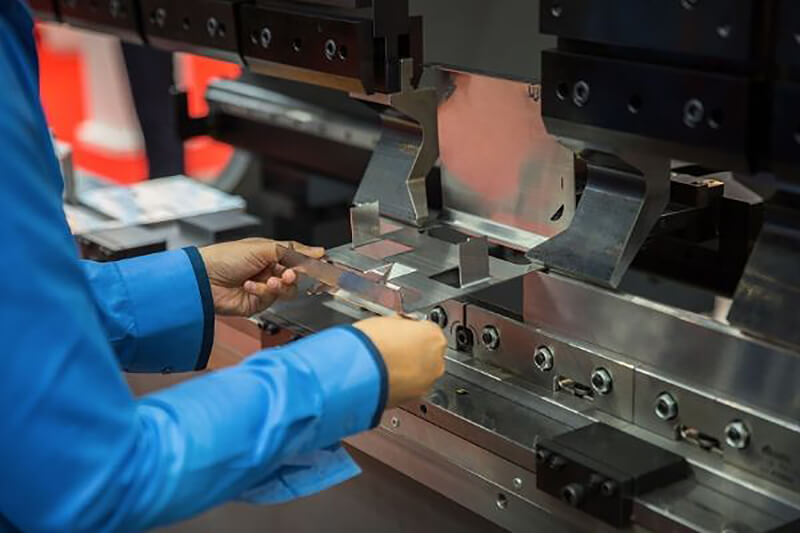
VII. Safety Measures for the Use of Press Brakes
Regular training: Operators must master the usage methods and various functions of the press brake.
Personal protective equipment: operators must wear safety eyes, gloves, ear plugs and other equipment.
Machine protective devices: The machine needs to be equipped with protective equipment, such as light curtain protection devices and protective fences.
Regularly inspect the machine: Check if the press brake is functioning properly and the components are intact.VIII. Why Is It Called a Press Brake?
IX. Conclusion
